Welcome to my blog where I'll be sharing updates on two MOOC courses I'm taking throughout the fall semester of 2019. My name is Michal and this blog was created for educational purposes.
Don't wanna be here? Send us removal request.
Text
Didaktická analýza (Kurz 1 & 2)
KURZ #1: LEARNING TO TEACH ONLINE
Vzdelávacie ciele: Vzdelávacie ciele kurzu boli nepriamo predstavené už na úvodnej strane pred vstupom do samotného kurzu v “About” sekcii. Kurz "pomáha rozvíjať porozumenie úspešných online učebných stratégií, ktoré môžeme uplatniť vo svojej vlasntej praxi," a "rozvíja chápenie efektívnych online vyučovacých postupov vo vzťahu s využitím rôznych technológií."

Po prejdení do samotnej platformy kurzu bola sčasti vzdelávacím cieľom venovaná len sekcia pod “Course Overview”:
“This course is not intended as a comprehensive manual for online teaching. Rather, it is intended as a starting point to help you develop your understanding of the principles involved; a place where you can get advice about strategies you might try; and a means from which you can begin to build your confidence and capacity to continue the learning journey in your own context and practice.“
Ciele boli teda predstavené textovou formou.
V sekcii “Course Overview” boli spomínané taktiež takzvané “learning outcomes”, ktoré boli definované nasledovne:
Jednotlivec po úspešnom dokončení kurzu bude schopný:
identifikovať význam využitia rôznorodých online technológií pri výučbe a navrhovaní kurzov,
zhodnotiť rôzne návrhy kurzov zahŕňajúce digitálne technológie a vhodné online vzdelávacie aktivity v danom kontexte,
predstavovať argumenty pri výbere konkrétnych technologií určených pre podporu online aktivít a kurzov
navrhovať online komponenty vo výuke s ohľadom na kontext (študijný plán či výhody a riziká online technológií)
vyvíjať stratégie pre hodnotenie a a zvyšovanie aktivity študentov v online kurzoch s cieľom zvýšiť efektívnosť daného online kurzu
Učebné ciele:
Učebné ciele boli opísanie priamo v úvode v “Course Overview”. Dokonca boli spojené i so slovami, ktoré používa Bloomova taxonómia.
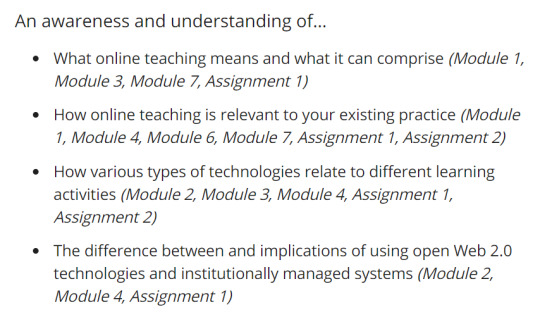
Táto časť tak bola rozdelená na štyri sekcie:
An awareness and understanding of …
The ability to analyse…
Confidence in applying new knowledge by…
A more reflective practice through…
pričom v každej sekcii bolo uvedené, aké dovednosti presne jednotlivec rozvíja po úspešnom dokončení daného modulu či úlohy.
Z Bloomovej taxonómie sú to teda úrovne: pochopiť, aplikovať, analyzovať a hodnotiť. Úlohy však mierili i na úroveň vytvoriť, pri ktorej je potreba nadesignovať/vymyslieť online aktivitu, avšak len v textovej forme.
Obsah vzdelávania:
lektori poskytujú základné poznatky k učivu vo forme videa
študíjné materiály sú poskytované na základe kvízov
2 povinné úlohy k úspešnému dokončeniu kurzu
MOOC
týždenná periodicita kurzu, lektori však počítajú s tým že každý jedinec môže mať iné vzdelávacie ciele, takže študenti nemusia prechádzať kurzom lineárna, avšak ak chcu úspešne absolovovať kurz, termín odovzdania úloh je pevne stanovený
Design, nástroje a prostredie kurzu:
prostredie kurzu Coursera
externé kvízy, ktoré generujú študíjné materiály (textové) na základe našich odpovedí
lineárny priechod kurzom, voľba nelineárneho priechodu kurzom
lineárny priechod kurzom:

Didaktické postupy:
videá, samoštúdium študijných materiálov, neznámkované kvízy (ale bodované)
motivácia – takmer žiadna, osoba vo vedení náhodne odpovedajúca na príspevky v diskusii
sociálna interakcia – diskusia s inými študentami
snaha o zapojenie sa do diskusie – vyzvanie študentov k tomu aby sa nebáli zdielať svoje rady a myšlienky; predstavenie sa
Hodnotenie a spätná vazba:
formatívny spôsob spätnej väzby – vzájomné hodnotenie dvoch hlavných úloh; priebežné kvízy, ktoré sú bodované ale neznámkované
spätná väzba – kvízy hodnotené automaticky systémom, dva hlavné úkoly hodnotené prostredníctvom vzájomného hodnotenia (každý žiak hodnotí jednu úlohu trom rozličným študentom)
finálne hodnotenie, od ktorého závisí úspešne dokončenie kurzu, je založené na spomínaných dvoch hlavných úlohách
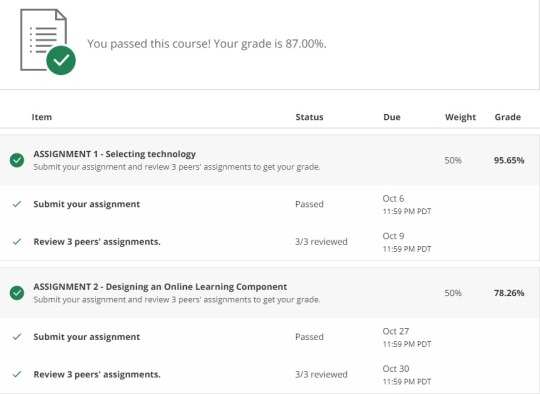
vzájomné hodnotenie je založené na kritériach

bodovanie úlohy + komentár
sebahodnotenie len v kvízoch
lektori nie sú zapojený, čo sa týka hodnotenia úloh
Prevládajúci vzdelávací prístup
Predpokladám že sa jedná o konštruktivizmus, keďže lektori pracujú s našimi prekonceptami (čiže s už nadobudnutými znalosťami), bez toho, aby medzi nami robili rozdiely. Je očakávané, že každý jedinec je na inej znalostnej úrovni. Interakcia s inými žiakmi v diskusnom fóre a vzájomnom hodnotení.
Poznámka:
Hneď v prvý týždeň bolo od nás vyžadované aby sme odovzdali jeden z hlavných úloh.
KURZ #2: Think. Create. Code
Vzdelávacie ciele:
Základným cieľom celého kurzuje je “learn how to code” and “learn the power of code” (zahrnuté v úvodnom videu).
Vzdelávacie ciele sú zahrnuté v sekcii “What You’ll Learn” hneď na úvodnej strane kurzu pred vstupom.
rozvoj zručností v oblasti výpočtového myslenia
úvodné koncepcie programovania, ako napríklad sekvenovanie, iterácia a výber
zručnosti a znalosti o tom, ako vytvoriť obrázky a prosté animácie pomocou ProcessingJS
príprava na štúdium informatiky alebo iných programovacích jazykov
Učebné ciele:
Učebné ciele sú stanovené priamo v kurze v rámci modulu 0. týždňa.

Z Bloomovej taxonómie sú to primárne úrovne: pamätať, pochopiť, hodnotiť a vytvoriť.
Obsah vzdelávania:
lektori podávajú základné informácie vo forme videa, ukazujú, ako kódovanie funguje (3-8 minutes)
kvízy, interaktívne kódovacie aktivity, diskusné fórum
vyplnené kvízy a úlohy k úspešnému dokončeniu kurzu
MOOC
týždenná štruktúra kurzu, avšak kurz je self-paced a je na danom jednotlivcovi, kedy dokončí dané úlohy, atď.
Design, nástroje a prostredie kurzu:
prostredie kurzu edX
externý editor pre kódovanie Code101x

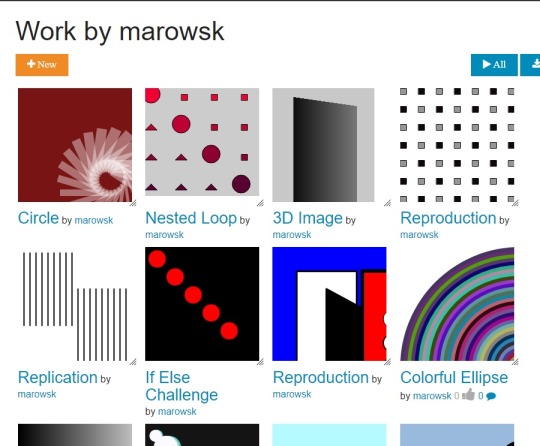
poznatky sú konštruované pre lineárny priechod kurzom, nie je to však povinnosťou


Didaktické postupy:
videá, samoštúdium študijných materiálov, bodované kvízy a interaktívne úlohy, ktorými sa jednotlivci učia kódovať
motivácia – takmer žiadna
sociálna interakcia – diskusia s inými študentami v diskusnom fóre + hodnotenie vývtvorov ostatných v komentároch
snaha o zapojenie sa do diskusie – vyzvanie študentov k tomu aby sa zapojili do diskusného fóra aspoň raz do týždňa
Hodnotenie a spätná väzba:
formatívny spôsob spätnej väzby – bodované kvízy (iba vo full verzii) a hodnotené úlohy
spätná väzba – študenti komentujú výtvory ostatných
finálne hodnotenie - 50% a viac = PASS

lektori nie sú zapojení do hodnotenia
žiadne sebahodnotenie, avšak uprostred kurzu kvíz na sebareflexiu
Prevládajúci vzdelávací prístup
Pravdepodobne sa jedná o kognitivzmus. Je tam síce určitá interakcia s ostatnými študentmi, avšak dôraz je kladený skôr na individuálnu prácu a precvičovaním si kódovania a riadením sa danej osnovy postupne.
0 notes
Text
Week 5 (Course 2)
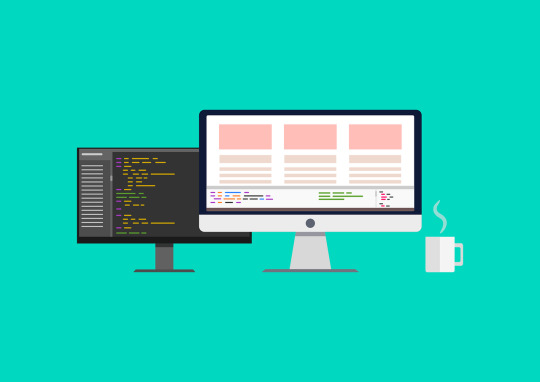
It's officially Week 5 of the Think. Create. Code course and I couldn't be more happier to be done with it. Despite enjoying the first week, it ended up being a very frustrating and chaotic period of time for me when it came to this course.
This is not the last week of the course entirely by the way. There is also a material for Week 6, which I will not check out. As for Week 5, this week's content was all about repetitions and algorithms and variables (again), but at the same time we were trying to add a little “flavour” to our pictures (the course called it a “creative flair”).
This week there were four assignments. Again, there were videos in which lectors told us the basics we needed to know in order to finish up the assignments. First one was basically creating a “3D” picture using gradient.
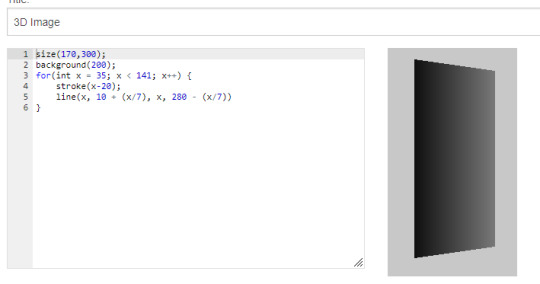
In second assignment they asked us to replicate a picture they provided, which ended up looking like this for me.
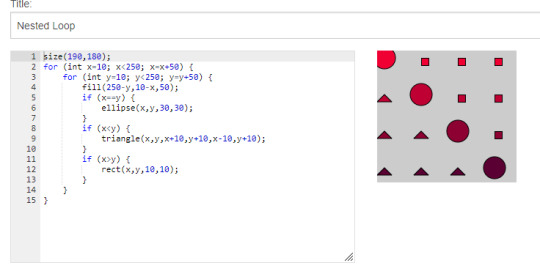
As for third assignment, I am particularly proud of that one because it ended up looking really nice in my opinion. They asked us to replicate a picture, and a kind of added a little “flair” to it in the middle to make it look like this and I ended up liking it.
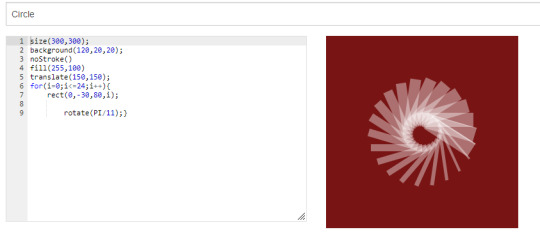
In fourth assignment we were asked to check any work from this or previous weeks, pick one and comment on it – what we liked and etc.
To be honest with you, this week really wasn't really that bad (as to compared to the previous 3 ones). But still, I kind of dreaded doing this after I got easily confused with all the numbers and variables and functions. It was just all too much for me. I guess I can say that at least I learnt some basic things and coding when it comes to Processing (they even said that some principles are used in other coding elements so that's good I guess).
One thing I really appreciate is the fact that we could have checked out work made by others and basically see how they did it. That was the most helpful thing for me, because sometimes the videos weren't really direct or I didn't understand them at that time, who knows.
Either way, I'm glad I'm done with this and I can easily say that I enjoyed the first course much more. This one just left me feeling confused.
0 notes
Text
Week 4 (Course 2)

Hello, everyone. In this week's course, once again, I've been a little bit frustrated and confused. I guess I can say that coding is not my specialty – this type of coding that is. I love using HTML but compared to Processing.js, it's much easier.
This week was all about decisions and “if”s and “else”s. There were four assignments in total. The first one was them, asking us to create a flowchart that could reflect one of our daily activities based on the “if” and “else” usage like in Processing.js. After some thinking, I have decided to create this.
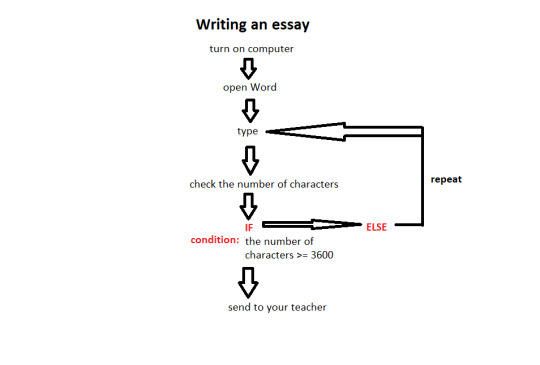
The first section of this week's course was really easy. There was also some quizz that asked us about how we are feeling about the course as of now. I, of course, typed in that I'm really confused and it's all to much for me.
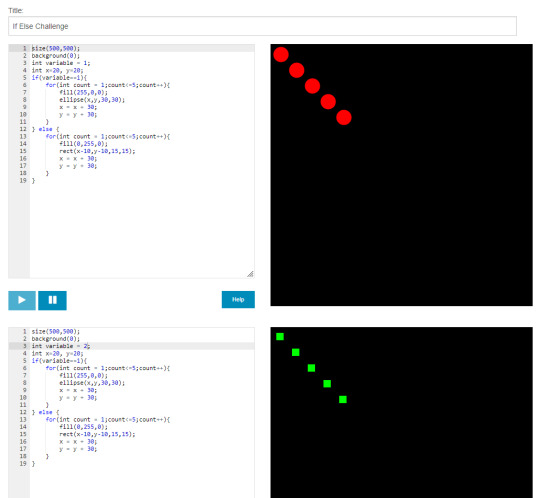
The second assignment was to replicate this pattern using if and else commands (I don't know if I can exactly call them that, but it's the term I'm gonna be using in order to not get confused with all the words like variables and expressions). Basically if you change the variable's number from 1 to other number, the ellipses will change to squares. I have struggled with this one already, but seeing other people making it helped a lot to kind of get the grasp of the whole concept.
The next one was another replication and the pattern isn't even interesting enough for me to insert it here. But once again, I have had to check other people's work to see how they did it. I guess, my mind wasn't exactly created for this type of activities.
The final assignment was to create a pattern of anything we know. I didn't really know what exactly I could do so I had decided to do this.
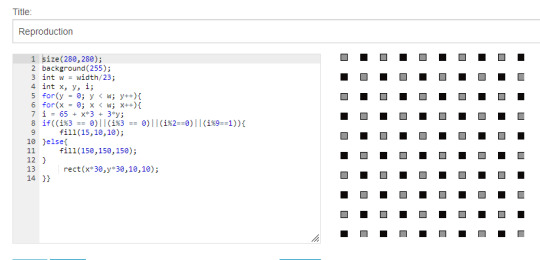
I have wanted to make a chess board first, but then decided against it. Kinda got creative with the whole thing. Of course I had to go back to see all the expressions and variables we have learnt and see some examples to be able to do this. But yeah, somehow I did it. I would rather just make all the squares manually than bother with repetitions I guess.
But yeah, as you can possibly feel from this whole post, I am nto really satisfied with the course. It's not that I think that the course is horrible or something. It's more like it's not my thing or I don't know enough about it to be able to quickly do all of this. The course is divided into 6 weeks as far as I know and the next entry will be last one. That means I will do Week 5 and be done with it. It sadly already feels like a chore, but I have to power through it.
0 notes
Text
Week 3 (Course 2)

My feelings about this whole course? I am really frustrated. I enjoyed the first week so much, but each week, it gets extremely harder and harder and I get easily lost. It is so hard for me to keep up, but I try, I really do.
This week we mostly learnt about repetition and how can we make typing codes less-consuming with that function. There was also a section devoted to flowcharts and what they mean in Processing.js context, which was informative.
As for this week's assignments – there were three. Most of them were about us replicating patterns they shared. Thanks to these patterns we were forced to use repetition function.

As I said last week, I said I would attempt to finish the last assignment from last week, but I wasn't able to, fully. It was just so hard for me to do. I genuinely tried to create something based on what they told us to do, but frustration got the best of me, so I have decided to move on. I understand the concept a bit better but not fully. Luckily, with this week's content, I was able to do stuff I was supposed to do. So not fully understand las week's section didn't stop me from continuing through this week.

Again, I was getting a little bit lost amongst all the numbers and new functions and variables but I tried my best to understand it. Now when I am looking at it, it is definitely not a course for me, despite them saying it's for everyone. Sometimes in videos, they start off easily and then suddenly give us a lot of new functions out of nowhere without explaining them and it annoys me so much. As hard as it is, I try to follow everything by trying out the functions on my own. Using the codes and practising them and seeing the final result and changes it makes really helps.

The final assignment of this week was to comment on other people's work and I have to say, some of them are real professionals since they were also using codes that were never explained. Made me feel a bit ashamed about my stuff, but whatever. I'm trying here.
It's kind of funny how I went from being excited about this course to struggling and questioning my abilities. I guess they made it on purpose that the first would be easy compared to others.
0 notes
Text
Week 2 (Course 2)

I have just finished the second week of the course called Think. Create. Code. and even though I really enjoyed the content last week, this week I really struggled with the assignments.
The content consisted of videos that explained variables, types and expressions in Processing Programming Language. First, they explained to us how to manipulate settings for the strokes of the objects, which was pretty easy. This module had an assignment, where we were supposed to draw a house using codes based on some criteria. I have done it and I have played with it a little. It was a little time-consuming but I wasn’t really complaining since it wasn’t bothering me at all.
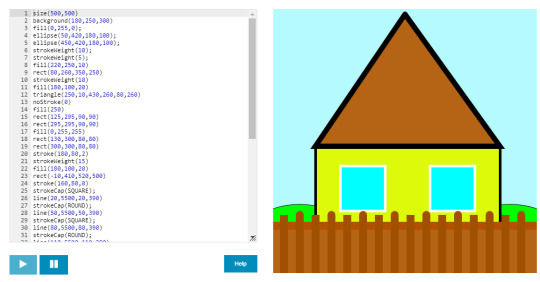
The second module is where it got hard. Again, the module consisted of some videos and examples and our task was to make some sort of a pattern using expressions which basically includes a lot of math. After a fair time of struggling I somehow created something presentable. What really helped me was seeing how others did their creations to get the basic idea.
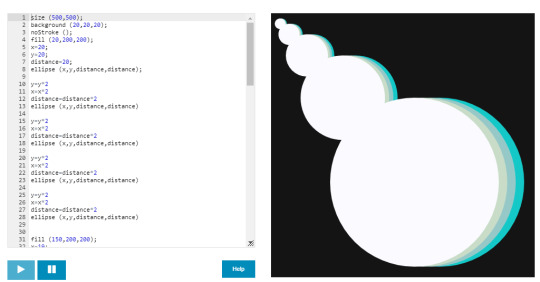
The third module was where I struggled the most, though. It taught us something more about variables and after finishing the videos, there’s an assignment – create moving cars. Basically create a car and somehow duplicate it over the portrait but not manually – we had to use variables to do so. And this is where the problem basically begins. I have no idea how to exactly do it. I have checked codes of other creations but some of them are really mastered, which basically means people who already know the Processing Programming Language did it, which frustrates me even more. I tried to see step by step how they did it, but it really wasn’t helpful for me. So this is the only assignment I haven’t done out of the three for this week. My plan is to check out some videos on YouTube about variables in Processing Programming Language and maybe I will understand it somehow.
This week really left me frustrated because of the last module. Other than that, I have checked every video and I did learn something – but I will have to go through the variables and expressions phase again to properly understand it, I suppose. Hopefully I will understand it a bit more so I can move forward to Week 3 with clean slate. After that I’m gonna try and finish the third assignment and I will give out updates on that in next week’s entry.
Last week I felt 10/10 when it came to that week and the course. Now I would say it’s 5/10 if not less, because the frustration got the best of me.
0 notes
Text
Week 1 (Course 2)

So, I'm done with Week 0 and Week 1 of the course called 'Think. Create. Code.' and I have to say I genuinely enjoyed myself.
The change of platform was a bit confusing to me at first but thanks to the Week 0, which consisted of stuff to help us get familiar with the content, I managed it pretty well in the end.
So, as I said before, I did not really know what I was getting myself into, because I never really thought there was a special coding system to create whole pictures or animations solely by using codes. But I'm really grateful me being afraid of failing didn't get in my way this time.
Week 0 was organizational stuff and videos, meanwhile with Week 1, we already jumped straight into coding. The coding system is called Processing.js (which I never heard of) and the platform allows us to code in real time to see what we're creating.
The Week 1 content consisted of videos that showed us a few tricks and codes, quizzes, practices and assignments. Unfortunately for me, I can't seem to be doing quizzes because the full version is paid, but I feel like the most important part in this course is to get the hang of the codes, which practices allow me to do so, so I will continue with the course anyway.
The first week taught us the basic stuff - setting size of the "portrait" we are drawing in, shapes and colors. First practice/assignment for this week was for us to use our creative side and create our face purely through the coding (specifically using only shapes and colors), which was pretty limiting in my opinion. After we created something we are satisfied with, we were supposed to share it in a gallery for others to see. The final step of this assignment was to check other portraits and pick the one we liked the most and give it a feedback. After I saw some of the creations, I had to admit that it was a limitation purely in my head because some of those were truly brilliant. Luckily, I could have checked the coding to see how they did it.

I'm really glad the course seems to be really practical, letting us figure stuff out on our own while giving us basic information. Maybe it's the lack of quizzes that makes me think it's mostly practical, but I genuinely enjoyed doing the stuff. Even though it was much more time consuming than the first course.
My thoughts right now? I'm feeling pretty positive about the whole course. The videos are pretty easy to understand and all it takes for you is to try it and experiment. We'll see what happens in next week, but for now 10/10.
0 notes
Text
Week 5 (Course 1)

The last week of the course is here. I have successfully finished all eight modules that were spread out over the 4 weeks. The last week and the last module (if you can call it that) is still there, though. Before talking about it, I would like to discuss about the assignment I have submitted and the three other assignments I have reviewed.
Assignment
The Week 4's assignment was connected to our first one. Basically what we had to do was to specify certain things – what exactly would students do, how does it align with the rest of curriculum of our class, what would we do to engage students and motivate them and also how we would evaluate our online course in order to see, whether it actually helps the class or not.
I have done the homework and already got feedback. I earned 18/23 points which is nice, I suppose. I feel good about myself and about all the work I have put into the assignment. I have reviewed other assignments and I have to say I was not surprised that no one, again, used any references to sources (thanks which you practically lose points if not used).
Questions & Answers
This last chapter of the whole course was very interesting, given it was just videos answering questions that were asked (in the past, I guess) in discussion forums.
The two lectors basically picked questions and answered them. Each module had a few Q&A. The whole structure of it weirded me out, to be honest. If I were them, I would basically just put the videos after each module but they have decided to do it this way instead.
As for the videos alone, I have to say, they were the most informative part of the whole course for me. There were so many questions I was actually interested in as well ("What are the current main challenges about teaching online?", "Handling copyright for online courses" or "How do you engage reluctant students" for example). There were really many of questions I found interesting, since the answers were based more on opinion and experiences. They even explained some terms I have never heard before (trailblazer or 'not invented here' syndrome).
After watching the videos (and believe me, it was a long journey), I can understand why they would put it all at the end of the course as its own module. But still, I also think that it would fit at the end of each module. Nevertheless, the videos were very informative and I enjoyed watch them.
Thoughts
Very positive. The green checks were really a huge motivator as well. It felt like an easy final chapter of the course thanks to which I was not really stressed about anything and just watched the videos and took notes of what I have found interesting. I guess I am ready for the next course, bring it on.
0 notes
Text
Week 4 (Course 1)

This week I was really busy so for the first time throughout this course, I'm typing out this diary entry entirely on my phone so hopefully nothing will mess up. This probably also means the entry will be much shorter than the ones I did before. As for this week's course, I surprisingly genuinely enjoyed both modules and found them both rich in knowledge. These two modules were really dependent on the experiences of other people, so I appreciate that.
Module 7
Module 7 was devoted to the topic focused on advices how to properly make students engage (more) in our (as teachers) online courses and also how to motivate them throughout the run of the course.
The most useful advice I have taken from the module would be that the our presence (as teachers) and guidance in online courses is as important as in "offline" classes, if not more. And that's practically because the absence of the teacher in any online course could mean demotivation.
Module 8
Module 8 was basically all about evaluation of the course we may designed or will design in future. In my opinion, it's really an important part of the course, as it shows that the course is not ending after you prepare the online course and grade your students, but you also need to see whether this type of learning is working for you as a teacher and for the studens - what can get better, what to change completely. That's exactly what evaluation is about. I think me, as a student of KISK, knows a lot about this topic since it's sort of something some professors always tend to focus on. In this case, what I've learnt is that you can do multiple types of evaluations for one course - self-reflection, peer feedback, student feedback and theory, in which theory means you're basically revisiting the studying materials to see if they're up to date.
Thoughts
Feeling very positive knowing I have learnt something and that I have enjoyed it. Again, I did the quizzes for both courses, checked oit the videos and also downloaded materials I found interesting and materials that could be useful in the future (hopefully).
Assignment
The second assignment of the course was set for this week. I, of course, already finished it and shared it but once again, I will write down what it was about in next week's entry after I grade other students and they grade me.
1 note
·
View note
Text
Week 3 (Course 1)

Third week of the course Learning to Teach Online is behind me. It is actually the halfway point of the course – just two more weeks after this. I have to say, I was really satisfied with the material they have provided for us, although, just like last time – one module was far more useful to me than the other.
Module 5
This is the module I have actually really enjoyed. Provided studying materials and videos were very relevant (I have to say it again, to me). Practically, what I have learnt in this module is that (once again), you have to think about the assessment itself before technology. There are also two types of assessment that were explained in the video – formative and summative (I didn't know about this before, or at least didn't hear about the terms). First one is in a form of a feedback the teacher gives to students throughout the learning process, meanwhile summarative assessment focuses on an overall feedback at the end of the learning process. Assessments in general generate feedback, which makes the student understand, where exactly they need to improve, but assessments also have to be related directly to learning outcomes (which we already get to know in Module 3).
This time, throughout the course, I tried to take more notes in form of keywords and I have to say they are really helping me reorganize my thoughts about what the certain module was even about. Also important note: technology is used to enhance assessment strategies – assessment strategies should not be modified to suit used technology.
This time around, I have only seen one optional video that interested me – Using Audio Feedback. Wasn't quite sure what to expect but I was really surprised at the way the technique was used. The professor was using Audacity, which sich a software where you can edit audio files and funnily enough I have actually worked in this software many years ago so it was a nice throwback in my eyes.
Again, did all the quizzes, read some articles, unfortunately, it felt quite like a chore – when it came to the quizzes. I don't really think they're useful when it comes to me – I don't like the fact that if you answer something wrongly (or you forgot to check all the correct choices in multiple-choice questions), it won't show you the right answer and I would actually be interested in seeing that. I get that the quizzes are mostly intended for a way to give us the studying materials we need, but still...
Important:
3 steps to take before fully implementing assessment online tool into any class:
allow practice using the tool;
trial the task for clear instructions;
create a back-up plan in case the technology fails.
Module 6
This module I have enjoyed far less than the one before. It was about (educational) online resources – how to get them, where to get them, why to even consider using them for yourself or your class and what to look at, if you decide to implement the knowledge or the source itself into your own (online or any) class.
In the main video, they mentioned informational literacy and how teachers need to make sure, that they are developing it in order to find and recognize reliable sources on the internet. I was really fond of this moment, because I (and we as students of KISK) should know a lot about information literacy, so I wasn't lost at all.
There was also the talk about copyright and creative commons license – the difference between them and when it is suitable for a teacher to use any materials for their classes. It was basically something, I have already learnt. I was kind of hoping they would provide practical examples.
From the optional videos, I have checked Understanding Creative Commons (Optional) which helped me remember some things about CC. Also checked Creating eBooks for Distance Education, but that one didn't really teach/show me a lot.
Did the quizzes. Read three articles from the recced links, but unfortunately I wasn't really enjoying myself – maybe it's the topic that doesn't sit with me well.
Thoughts
No assignments this week. There will be one next week so I am looking forward to see what it will be about. As for this week's modules, it was really 50/50. Hopefully I will enjoy both modules for Week 4.
0 notes
Text
Week 2 (Course 1)

The second week of the course Learning to Teach Online is successfully done. In the next couple of paragraphs, I would like to talk about my progress, about the assignment from Week 1 and the Modules 3 and 4.
Generally speaking, I have enjoying this week's content. Between the two, the Module 3 was much more enjoyable for me, though. Still, it wasn't something I'd be forcing myself to do, so I guess that's a good sign.
Assignment (Week 1)
In my last entry, I said I would be talking about the assignment which I have already submitted. The assignment was basically about us, trying to come up with some idea about what kind of online activity we could incorporate into our class we are teaching (or we would want to teach, in my case) and what technology we would use. Since I am not teaching any classes, nor I think I will in any near future – I have picked english as a secondy language for high schoolers as my “ideal” class for this assignment. What I came up with was basically an activity, where the students would join tumblr, follow my (as a teacher) blog and weekly, I would post a video in english language (in any accent) and their assignment would be to write down the whole transcript of it (since I believe, and also read about it, that you can learn a lot from movies/shows/videos when it comes to english language). They could work in groups, they could message each other anywhere (including Tumblr), but by the end of the week, each of them would have to submit the whole transcript. It was explained much more in detail in the assignment itself, so this is just for the general idea.
After finishing the assignment, using sources to support my arguments (they told us to link sources in one of the videos and never actually explained it in the assignment text, which was... somewhat weird, but luckily I have watched everything) and submitting it, 3 people have reviewed it (it was a peer-graded assignment) and my final score was 22/23 so I am happy about that.
To finish Week 1, I had to review 3 assignments as well. At times, It was hard for me because I did not want to be the “bad” person giving out bad scores (yeah, 2 people were not referencing to sources at all, sometimes even forgot parts of the assignment), but then I realized that I need to be objective in order to learn. Also, I feel like I need to mention that I was kind of put off by the fact that we could see the name of the person we were grading the assignment of, and I know that this is MOOC, but still, I'm kind of used to the anonymous peer-grading (one person I was grading is actually also in ISKM61 course, that's why I was surprised to be able to see the names).
Module 3
Module 3 was mostly about reflection, as in, they were talking about the most important step you need to take when designing an online activity/course for a class – you need to consider whether the technology and the activity you wanna incorporate into class is actually needed and will actually help you and the students.to achieve their learning outcomes. Curriculum alignment is the word they used, I believe. They explained it as something, where learning outcomes, content, activities and assessments are all directly related to each other and need to be considered when designing an online activity or course. I appreciated this part mostly because I am more of a technology guy, pedagogy never seemed very necessary to me (I know it is, but I need to be constantly reminded of it, because sometimes I prefer technology and do not think about other aspects when designing stuff).
To keep this short, I am just going to write down two sentences I have written down when watching the videos, because I found them very important and well said, when it comes to this context.
“Technology should not be the driver of your curriculum development.” “If the technology does not serve a useful purpose, don’t use it.“
Other then that, I filled out both quizzes in this module, answered a question in the forum, but did not really focus on the provided literature they offerec, because, to be frank with you, it did not really interest me (from what they have offered, checked out some links, but I did not consider them to be very interesting).
Module 4
As for this modul, I found it really dull. It was mostly about how technology is available for enhancing online activities and which possible types of technology we could consider to use for our needs. The videos from the lectors were very short and the whole module mostly depended on the optional videos that consisted of case studies of some ways people have used technology in education. The whole module was basically about which technology you could use for your class (meanwhile module 3 was explaining to think about whether it is needed at all as I mentioned). They did not really offer any exact names of technologies. Except for the mentioned optional videos of case studies – which were very dated. I mean, they were talking about things like Flickr or Second Life, and I guess it was nice to see it in practice but I do not think it taught me something new. There was also a case study about video conferencing, which was I guess the most current case for use of a technology in education out of the ones offered.
I just did not like how the course was build. Not to be fully negative, though – I did download two of the recommended materials which I found interesting (will check them out closely next week) and also they still made some interesting points:
– consider pedagogy before technology – technology is not going to solve the issues that people have when it comes to teaching and learning, the technology needs to actually add, or challenge their learning or add to their learning
Also forgot to mention that there was a nice idea amongst the case study videos – clicker activity. I actually experienced the same activity in one of my classes. Basically, the teacher sets up some questions for the class (like through a website), gives the class a link to the site and the students get an access to it through their devices (like phones or laptops) and answer one question at a time for the teacher to see how many people picked the choice A and how many people picked the choice B, etc.. In my case, it was really an enjoyable and engaging activity (mixed with winning a pen or something if you got the most points after the class ended) for the class. Note: To avoid confusion, in the video the course offered, they were talking about a clicker software, which one could consider dated since a web service can do the same now (even show you the results in real time just like the software did, and also without any needed remotes, although in this case, you need to depend on student having their own devices).
Thoughts
I would say that’s about it. This entry is already quite too long. Despite the Module 4 being kind of a let down for me, I still enjoyed this week and am looking forward to Week 3.
Note for myself: take more notes when going through the course.
1 note
·
View note
Text
Week 1 (Course 1)

I finally went through the first week of the Learning to Teach Online course. My feelings were mixed when starting because I had no idea what to expect and thought there would be chaos taking over. I was luckily wrong.
The whole course had started with an introduction video and text in which the needed introductory information was thoroughly explained.
Each week there are two modules and each module has videos, articles and “tests” (self-evaluation and knowledge quizzes you’re taking for yourself). and there will be also 2 peer-graded assignments throughout the course.
It put me at ease knowing you are not forced to do everything or follow the modules as they are designed (I will follow them and try to read/watch/do all the videos, articles, tests and assignments, but just the thought of possibly forgetting to do something and not face any consequences for it is relaxing enough).
The whole platform has been easy to adapt to and after introducing myself in the discussion forum, I went straight to Module 1 and Module 2. It took me some time to finish both and do the assignment on top of it, but at least I’m feeling really accomplished right now.
Module 1
This module’s purpose was to explain why it’s so important to include technology in your teaching nowadays and how blended-learning and fully online teaching can be an advantage for the teacher and the students.
I particularly appreciated the video (funnily enough it was the optional one), where teachers and students were talking about their experiences using online technology to teach and study. What mostly stuck with me was when one of the students said that one can feel “isolated” when they’re undertaking an online course (as an example for possible negatives for fully online education) and I have to say I finally found a name for how I mostly feel when I’m taking fully online courses – it really is isolation. Even kind of felt it while I was going through the first and second module of this course, but the provided videos, where the two teachers (who run the course) explain things, helped since it felt more personalized and the feeling of isolation was slowly disappearing thanks to that.
The whole course is about auto evaluation and working with your own knowledge and experience of others – what I actually learnt from this module is that even something little as a video that shows the teacher/s speaking can help make the online course feel more alive. Also noticed that for me, the discussion forum didn’t really help with the whole isolation thing – it’s mostly just people with faceless accounts to me, but hopefully it will change as the time goes by and I will contribute to the discussion forum more.
Module 2
Module 2 was more knowledge-based. I’ve actually learned (or “re-learned”) some things about institutionally supported technology (e.g. LMS) and open access technology (e.g. social media) used in educational context.
Again, went through the videos, the readings and the quizzes and the thing I haven’t really realized before and found interesting was that there is a huge risk and a huge responsibility concerning the open access technology if used in education. What I’ve learned is that if teacher decided that students should use an open access technology as a part of their class activity/assignment/etc. (for example, setting up Twitter and use it to tweet out opinions on some matter using hashtag, so the teacher can go through it), the teacher is actually responsible for the students’ privacy. Meaning, if the student (even in future) were to get attacked by some people on Twitter for tweeting out those things and the student would complain to school – the teacher would be responsible. It kind of makes sense, but it kind of doesn’t as well?
Assignment
I have submitted my assignment and I have yet to review 3 of them. As soon as I review them and as soon as I (hopefully) get feedback, I will type out my feelings about it and what the assignment was actually about in next week’s post (along with my thoughts on Module 3 and 4).
Thoughts
I appreciate that the course is designed the way it is – after I go through the quizzes, it actually gives me a list of recommended and personalized sources that could be helpful for me based on the answers I have given. Already saved three of them because I found them to be really helpful. Hopefully this positive feeling will stay with me as the weeks go by.
1 note
·
View note
Text
Introduction (1st Assignment)

Good evening, everyone. In this article, I’d like to talk about a few things, the first one concerning the reasons I decided to sign up for ISKM61 Online vzdělávání: MOOC. After that I’d like to introduce you to the two MOOC courses I have picked to attend throughout this semester and to talk about on this blog as weeks go by.
Why taking this class (ISKM61)? Simple answer would be that it’s a ‘flexible’ course when it comes to time management. But I would also like to say, that I’ve been interested in these things (these things being educational technology) for a while and scarily enough I have never experienced taking a full MOOC course yet – as in, MOOC courses in which you enroll and need to follow the dates. I’m more of an ‘in-my-own-time’ type of guy, so it will be probably challenging to be keeping up with this weekly type of course. I’m really excited to do this and to further improve my english language skills as well.
Which two MOOCs have I picked? The first MOOC course I have picked and that works on weekly basis is called Learning to Teach Online. It’s five weeks long and begins on 7th of October 2019. This course is aimed mostly for educators who already teach classes (it’s not compulsory though, from what I’ve gathered) and want to find an efficient way to include technology in any capacity in their classes. The reason I picked this is that it’s supposedly focused more on the technology part than on the didactic one. I would also like to kind of “infiltrate” this soon-to-be online class full of educators and try to learn from their real-life experiences. I feel like this course could challenge me and teach me something new concerning edTech.
The second MOOC I have picked is self paced. The name of the course is Think. Create. Code. and the course itself introduces a topic that focuses on digital information and codes. Nowadays, everywhere I go, words ‘digital’ and ‘codes’ scream at me. I have never really been a friend with codes – what exactly are codes? I’d like to see what’s the whole fuss about. The reason I picked this course is not only the demand for knowledge of “codes”, but also the fact that I would be going completely blind into the course and I think that’s challening. The section where it says “Prerequisites: None” is kind of calming, though.
I’m a graphic designer, I know how to use Photoshop, InDesign, Sony Vegas, etc. but I would also like to use this knowledge to create something useful – online courses for example. That is mostly the reason I picked the first course. As for the second one, I’m working with images, I’m working with animated images and I know what HTML or Javascript is. Yet, I have no clue what kind of coding will be used in the second course and I would like to try and see what it’s about with the goal of learning something new and fresh.
1 note
·
View note